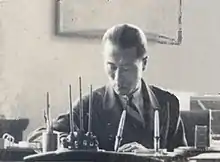Wong Tsu
Wong Tsu (also known as Wong Tsoo, Chinese: 王助; pinyin: Wáng Zhù; 10 August 1893 – 4 March 1965) was a Chinese aeronautical engineer who was the first aeronautical engineer at Boeing.
Wong Tsu | |
|---|---|
 | |
| Born | 10 August 1893 |
| Died | 4 March 1965 (aged 71) |
| Nationality | Republic of China |
| Education | Massachusetts Institute of Technology |
| Engineering career | |
| Employer(s) | Boeing |
| Awards | Acknowledged as first Boeing engineer at the Museum of Flight |
Life and education
Wong was born in Beijing, Qing China. At the age of 12, he was selected as a naval cadet; at 16, he was sent to England to study naval engineering, then to the United States to study aeronautical engineering at the Massachusetts Institute of Technology (MIT) during the period of great social and political upheaval in China.
Work
Wong graduated from MIT with a degree in aeronautical engineering in 1916. He then learned to fly at the Curtiss Flying Boat School in Buffalo, New York. In May 1916, the fledgling Boeing Airplane Company hired Wong as their first trained aeronautical engineer.[1][2] He helped design the company's first successful product, the Boeing Model C,[3][4] more than 50 of which the U.S. Navy purchased.[3] In light of the financial windfall brought from the Navy purchases, "from Bill Boeing onward, the company's chief executives through the decades were careful to note that without Wong Tsu's efforts, especially with the Model C, the company might not have survived the early years to become the dominant world aircraft manufacturer."[4]
Wong brought considerable expertise in wind tunnel testing to Boeing, and advised on the design of the Boeing Aerodynamical Chamber at the University of Washington. In 1917, after around a year at Boeing, he returned to China where he became chief secretary of the airline China National Aviation Corporation. From 1934 to 1937, he served as the chief engineer of the Central Aircraft Manufacturing Company, (CAMCO) a joint venture between China and Curtiss-Wright Corporation, Douglas Aviation, and Intercontinent Aviation.[5]
When the Kuomintang government was defeated in the Chinese Civil War, Wong went to Taiwan where he became professor of aviation at National Cheng Kung University. He died on March 4, 1965 in Tainan at the age of 71.
During his lifetime, Wong designed more than two dozen aircraft.[6] In 2004, Boeing unveiled a plaque and exhibit at the Museum of Flight in Seattle, Washington, honoring Wong's work as its first engineer.[7]
References
- "The 1st...and the Best" (PDF). Boeing.
- Areddy, James (24 September 2015). "The Chinese Birdman Who Got U.S. Aircraft Giant Boeing Flying". WSJ Blogs - China Real Time Report. Retrieved 2016-01-22.
- Bauer, Eugene (2000). Boeing: the first century. TABA Publishing. p. 18. ISBN 1879242095.
- Fallows, James (2013). China Airborne: The Test of China's Future. Knopf Doubleday. p. 50. ISBN 9781400031276.
- Arnold, Doris ("Missy") (2008). Missy's China, Letters from Hangchow 1934 -1937. Hong Kong: Old China Hand Press. pp. passim. OCLC 488467698.
- 'Past Experience: Boeing’s Long History with China'. Seattle Business Magazine.
- Vu, Carol. "An aviation pioneer, no longer forgotten". www.nwasianweekly.com. Retrieved 2016-01-22.
External links
- Eve Dumovich, "The 1st and the Best"